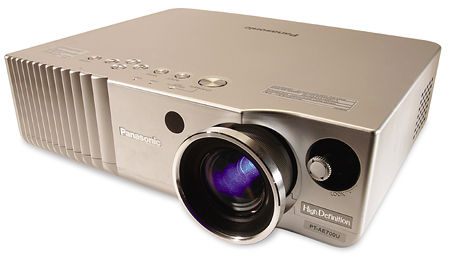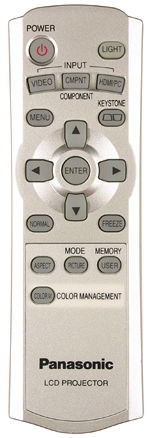Panasonic PT-AE700U LCD Projector
We've reviewed several Panasonic projectors in the past few years. Their price ranges have varied slightly, but two things have remained constant: a decent picture and an ugly box.

With the PT-AE700U, Panasonic has taken strides in sprucing up the industrial design, with rounded edges and a new silver color. It's still not as attractive as other projectors in this price range; but, when the lights are out, who really cares? It's the picture that matters.
Setup was the easiest of any projector I've ever reviewed. On the front, next to the lens, is a small joystick that moves the picture around the screen in two dimensions. While it's not as sexy as a motorized lens shift, it's significantly simpler and more effective. With a twist, it locks into place. Panasonic calls this a shift lever. I have a shift lever in my car, but it does something different. Controls for the focus and zoom are on the lens, and they offer fine control for the last dimension of setup. This is the home-theater-installation version of Occam's razor.
Like the case, the remote is functional, if nothing else. It has discrete input and aspect-ratio buttons, and it's backlit. Stay away from the "Normal" button, as it resets everything to the factory defaults. Why there's a button on the remote for this is beyond my comprehension.
Plug it in; plug it in
The menu system shares its DOS-era aesthetics with previous models, but thankfully it also shares the earlier models' depth of settings. From basic setup all the way to gray-scale adjustments, you can fine-tune the PT-AE700U to do just about anything you want. I'll take a less-flashy menu system with this much functionality over the opposite any day. The latest thing in projectors seems to be an iris (the running theme with all of the projectors in this issue). In the case of the PT-AE700U, the iris (Panasonic calls it a dynamic iris) tracks the incoming video signal and adjusts the iris, lamp power, and gamma accordingly. The dynamic iris will brighten a bright scene and darken a dark one. In this case, it increased the full-on/full-off contrast ratio between 30 and 80 percent, depending on the bulb setting. This type of iris can't work magic, though. The ANSI contrast ratio of 161:1 is more of what you're likely to see on-screen. In a difficult scene, like chapter 2 of Master and Commander, the black background may seem darker, but so do the light portions of the image. On this projector, the dynamic iris certainly helps, but it doesn't do a whole lot. This projector's real strengths lie elsewhere.
 Color is so often overlooked on projectors. In the never-ending pursuit of light output, color accuracy will be sacrificed for a few more lumens on a spec sheet. The PT-AE700U had some of the most accurate color points in a projector in this price range (and several other price ranges). This leads to a very lifelike image, with all colors appearing more natural. This naturalness is aided by the gray-scale tracking, which isn't perfect but is good enough to not be distracting while watching actual video material. Like most LCD-based displays, "absolute" black (a relative term here) has a slight color tint, in this case blue. It's not as bad as many I've seen come through the studio, but there are better.
Color is so often overlooked on projectors. In the never-ending pursuit of light output, color accuracy will be sacrificed for a few more lumens on a spec sheet. The PT-AE700U had some of the most accurate color points in a projector in this price range (and several other price ranges). This leads to a very lifelike image, with all colors appearing more natural. This naturalness is aided by the gray-scale tracking, which isn't perfect but is good enough to not be distracting while watching actual video material. Like most LCD-based displays, "absolute" black (a relative term here) has a slight color tint, in this case blue. It's not as bad as many I've seen come through the studio, but there are better.
Many digital displays also have a problem with reproducing a smooth transition from light to dark, such as from a shadowy area to a brightly lit portion of the image. Again, the PT-AE700U was smoother than most. Test patterns revealed some slight steps and a little noise, but, in actual video material, it wasn't nearly as apparent.
Processing was also top-notch. The projector picked up 3:2 film sequences quickly, and there were very few artifacts, even on tough scenes (like chapter 12 of Gladiator). The Panasonic decently handled even difficult video sequences, like the waving flag on Video Essentials, with only mildly jagged edges. Overall, the projector seemed slightly less sharp than a few other LCD projectors of the same resolution, but this was so subtle that it's doubtful you'd see a difference unless they were side by side.
Another trait common with LCD projectors is the so-called "screen-door effect," in which the space between the pixels is visible. While not quite as good as DLP or certainly LCOS, the PT-AE700U is significantly better (that is, it's less of an issue) than most LCD projectors.
Summing up the PT-AE700U is pretty easy. It is a bright projector for the color accuracy it provides (always a bonus), with deinterlacing that won't require a progressive-scan DVD player. Its black level isn't great (typical of LCD projectors), but it has enough qualities (like price) that should make up for it. Your mother was right: Beauty is on the inside.
Highlights
• Simple and flexible setup
• Accurate color























































